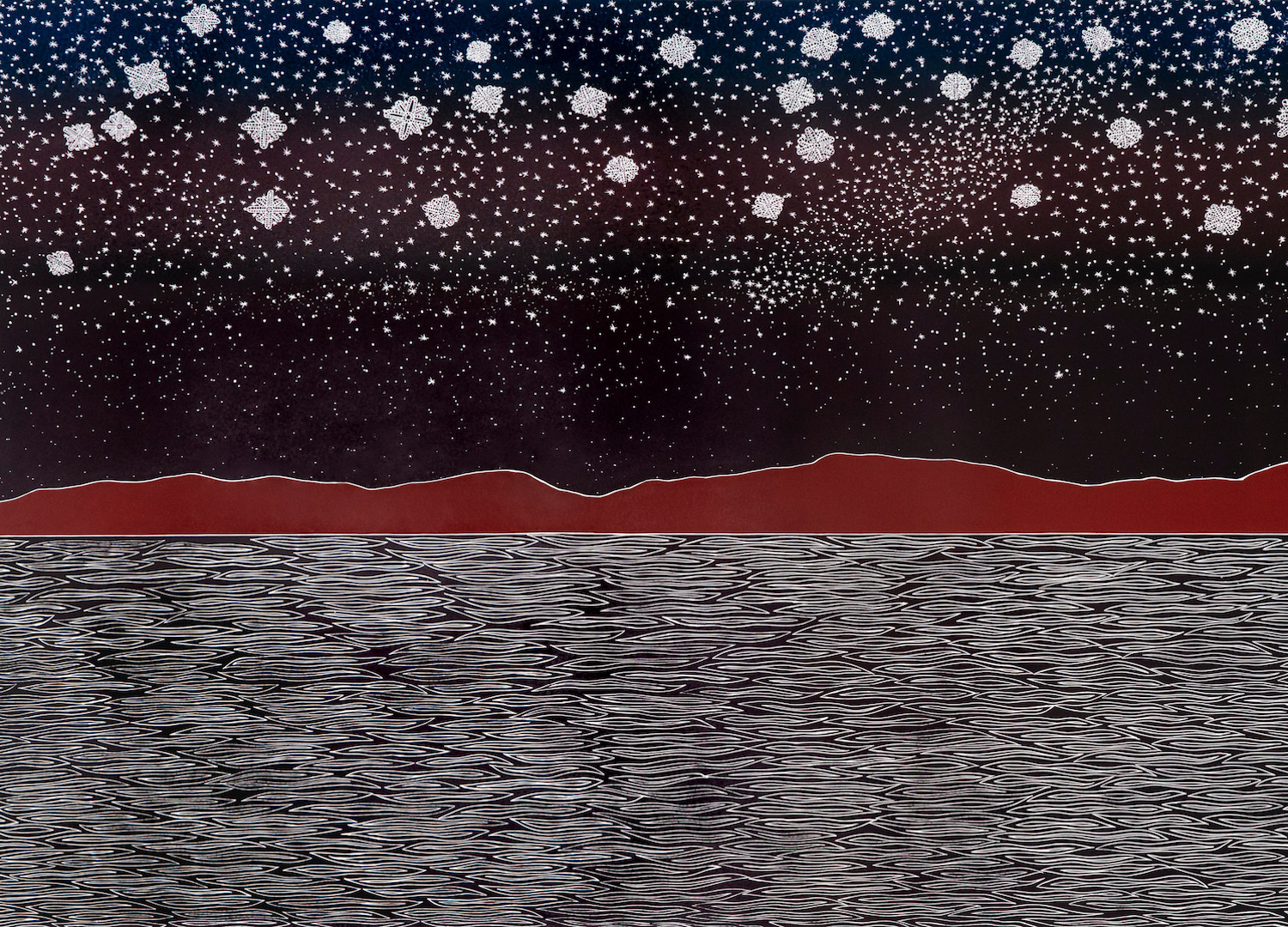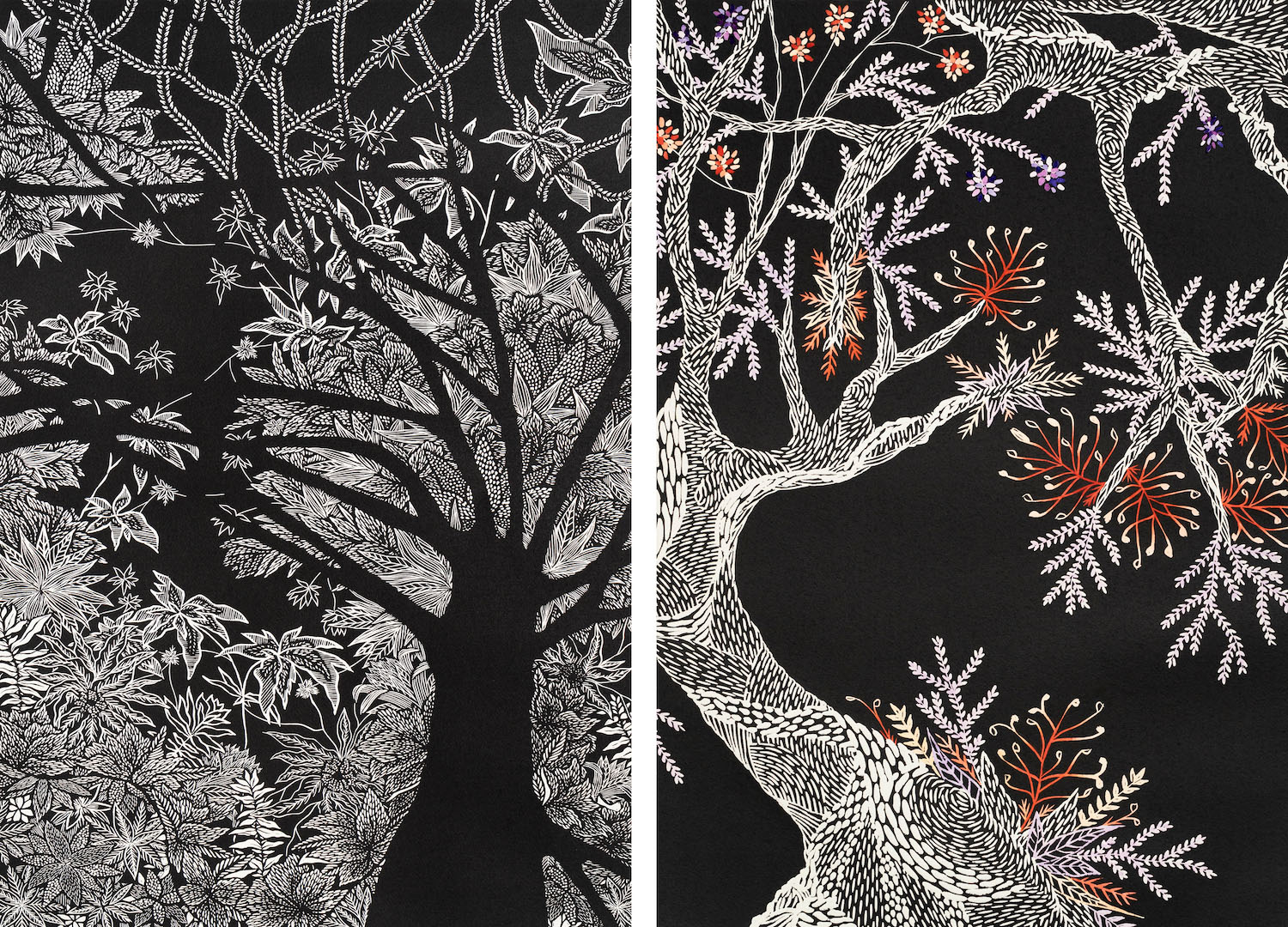
Masters of Country: A Guide to the 2022 Cairns Indigenous Art Fair
top image ‘ANI, IPI, ACHAH’ (‘LAND, WATER, SKY’) BY TEHO ROPEYARN. PHOTO BY LOUIS LIM. COURTESY OF THE ARTIST AND ONESAPCE GALLERY.
The ever-vibrant Cairns Indigenous Art Fair (CIAF) will return to Far North Queensland next month to showcase the immensely talented and innovative First Nations artists the state has to offer.
From 6 July through to 10 July, the fair will descend upon the Cairns Convention Centre, alongside a number of satellite events and exhibitions, to spotlight approximately 300 visual artists and 150 performers across the mostly free, multidimensional program.
This year’s theme, ‘Masters of Country’ – a continuation of themes that talk to Country through a focus on sacred sites, water preservation, climate change, and intergenerational and cultural storytelling – will be Artistic Director Janina Harding’s swan song with CIAF.
“Queensland has the most diverse indigenous [flora] of any state or territory, with 14,000 known species,” Janina says. “It is not a coincidence that Queensland’s First Peoples have an innate connection with indigenous plants and trees. We were born into the oldest living culture in the world. It is no wonder that we have a distinct knowledge regarding the use of plants and trees from our homeland. We have always had and always will have experts on plant knowledge. In today’s terms, our people are botanists, doctors, nurses, chefs, nutritionists, gardeners, architects, builders, pharmacists, arborists, physicists and horticulturists.
“Queensland First Peoples also have oral stories, and lived experience, derived from the many trees on Country. We have birthing trees for childbirth, scarred trees for watercraft and utensils, tree markers for significant or sacred sites, knot trees for directional signposts on Country and carving to tell our cultural stories. Trees are our history books and a testament of our resourcefulness.”
Our people are botanists, doctors, nurses, chefs, nutritionists, gardeners, architects, builders, pharmacists, arborists, physicists and horticulturists.
Ahead of this year’s event, and to learn why art fairs such as CIAF are the ultimate platform to amplify diverse artistic identities, we had a yarn with CIAF Marketing and Communications Manager, and exhibiting artist, Jack Wilkie-Jans.
images ‘BOUCHAT’ AND ‘LAGOON (BACK BEACH)’ BY JACK WILKIE-JANS. PHOTOS BY MICHAEL MARZIK. COURTESY CAIRNS INDIGENOUS ART FAIR.
Tell us a little bit about who you are and your work!
My name is Jack Wilkie-Jans and I’m an artist, writer and the marketing and communications manager for the Cairns Indigenous Art Fair (CIAF). I’ve been working in the art industry for around a decade, but am only now getting into the full swing of things! I’m Aboriginal and English combined, so the duality of my cultural heritage is something I incorporate into my practice as an artist and my overall work in cultural conservation and growth, and legacy planning for my peoples – which, really, is what all who work in the Indigenous art sector do.
The duality of my cultural heritage is something I incorporate into my practice as an artist and my overall work in cultural conservation and growth, and legacy planning for my peoples.
As an artist, I’ve dabbled in photography and videography though I’m primarily a painter. I’m a bit of a fair-weather painter; I’ll often go great spells without even touching a brush (I think this depends on if I’m doing more writing than painting at the given time – I rarely do both together, because I usually endeavour to say the same things across both modes.) I’ve recently completed a new, small collection of works to be exhibited at CIAF – I’m fortunate to be showing again this year, this time as part of the Independent Artists Group Show booth in the fair. These works are a departure from my usual abstract and neo-expressionist styles, which I tend to oscillate between. Aesthetically, the newer works have been inspired by a number of great artists working today (Zak Tilley and Zoey Grey to name a few) and I’m seeing myself go down the abstract-landscape path. However, I’m not sure how long that will last. And naturally, these works were created in response to the theme for CIAF this year: Masters of Country. As such, I reflected upon the Country I predominantly grew up on in Weipa. I can’t wait to go back home soon!
You’ve spoken previously about the “viewing [of] traditional Indigenous works as little more than ‘native curiosities.’” Why do you believe this narrative persists?
It’s because most non-Indigenous peoples really have a lack of awareness around either true Indigenous cultures, or at least, the way we would wish them to be perceived generally. At this stage in the game, this is simply because people aren’t inclined to expand their circles and move into a learning of another cultural background, outside of their own normative society. There’s simply far too many great Indigenous-run endeavours and events, like CIAF, which are putting our cultural values and insights out there to the world, for people not to know that we are more than vague dot paintings and mass-produced boomerangs at beach-side souvenir stands. I don’t believe any ignorance is malicious, just symbolic of a lack of motivation and the ease of presumptive opinion.
image ‘IPI‘ (‘WATER, RAIN’) BY TEHO ROPEYARN. PHOTO BY LOUIS LIM. COURTESY OF THE ARTIST AND ONESAPCE GALLERY.
How can art festivals like CIAF help fight stereotypes and amplify diverse artistic identities?
Literally in everything we do. But mainly – and this is true of any in-person art event – because you have a great few days to meet, re-meet and meet again with the artists, lore-keepers and cultural practitioners themselves. Like with any stereotype, be it negative regarding Indigenous peoples, or a stereotyped view of Indigenous art, they can be dispelled through connection and dialogue. Art fairs are great platforms for such exchange.
Like with any stereotype, be it negative regarding Indigenous peoples, or a stereotyped view of Indigenous art, they can be dispelled through connection and dialogue.
What are your top picks for this year’s festival?
My, this is a tough one! I think that every element of the CIAF program is amazing and incredibly overdue to return to physical delivery. Because there’s simply too much happening this year for me to recommend any one thing, find out for yourselves at ciaf.com.au.
The past two years saw the festival move online due to COVID-19 uncertainties. What does it mean to the CIAF team and showcasing artists to be back in person?
CIAF still has ambitions to showcase digital content going into the latter part of the year and years beyond. We found this to be a crucial element to reaching audiences who – COVID-19 or otherwise – were always still unable to travel to Cairns each year (for a wide number of reasons). However, we are indeed relishing in being able to showcase art, artists and audiences all together from 6–10 July once again.




